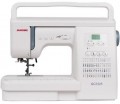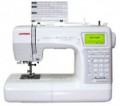Number of stitches
The number of stitches that a sewing machine can sew. The larger this number, the more extensive the capabilities of this model, the wider the choice the user has; however, it wouldn’t hurt to clarify the specific range of supported stitches separately.
The fewest options - mostly up to 25 - are provided in electromechanical machines, as well as specialized devices such as overlockers and carpet lockers (see “Type”). In computer-controlled devices, the number of lines can be in the dozens, and some also allow you to download additional options from the computer.
Number of loops
The number of loops that the sewing machine can sew. Different types of loops are used for different types of fabrics and clothing. The larger this number, the wider the choice of the user and the less likely it is that the loop of the desired type will not be in the arsenal of the machine.
Max. presser foot height
It is the distance from the work surface to the presser foot in the highest position. It must be taken into account when working with thick fabrics.
Sewing speed
The maximum sewing speed provided by the sewing machine. In the vast majority of models, this parameter can be adjusted, so that, if necessary, you can sew at a lower speed.
The more stitches per minute the machine makes, the higher its productivity, and the better it is suitable for large volumes of work. At the same time, note that high speed has a corresponding effect on price and power consumption, and it is not always required. Detailed recommendations on choosing the optimal speed for certain types of work can be found in special sources.
Features
—
Alphabet letter embroidery. The ability to embroider letters of the alphabet using a machine. This function is found in computerized models. It is carried out due to a set of letters entered into the memory of the machine. Many models with this feature have several built-in fonts, and some even allow you to upload your fonts from your computer.
—
Differential bottom feed. The fabric feed consists of two gear racks — in front of and behind the needle. Depending on the set mode, such a feed can additionally stretch or, conversely, collect fabric during sewing; the first is useful when working with dense fabrics, the second — for knitwear, stretch and other easily stretching materials.
—
Reverse stitching. A function that allows you to switch the direction of movement of the fabric under the needle and, accordingly, the direction of the seam. Mainly used for stitching. The reverse is practically obligatory for sewing machines in the classical sense of the word — electromechanical, computerized and sewing-embroidery (see "Type"), but practically does not occur in other types.
— Free arm. A device for working with sleeves, trousers and other similar parts of clothing. This function is most often implemented due to the removable part of the desktop — when it is removed, the table turns into a narrow platform. The specific width of such a device ma
...y be different, it should be specified separately.
— Needle threader. A special device designed to facilitate the process of threading a needle. The presence of a needle threader is especially useful when changing threads frequently (for example, sewing alternately with different colours).
— Thread cutter. A mechanism for cutting the threads after sewing, eliminating the need to use scissors: to cut the thread, just press the button. Note that we are talking about an automatic thread cutter; hand tools mounted on the bodies of some machines are not considered thread cutters in this case.
— Pedal free sewing. The ability to use the machine without connecting the pedal. To start and stop the process in such models, usually, a special button is provided. Such an opportunity can be useful for long sewing when it would be tiring to keep the pedal constantly depressed, and for occasional use, when the machine starts “for a couple of stitches” and there is no need to fiddle with connecting the pedal.
— Twin needle sewing. The possibility of using a machine for sewing with a twin needle — a pair of needles fixed in one holder. There are different types of such needles and different methods of working with them, and some work is done only with a double needle. Anyway, the use of such devices requires that the machine be initially compatible with them.
— Needle stop switch (top/bottom). A switch that allows the user to select whether the needle will be in the up or down position after the motor stops. In the absence of such a switch, the needle, usually, stops only in the upper position, and this is not always convenientAdjustments
—
Presser foot pressure adjustment. The ability to change the degree of pressure of the foot on the fabric, adjusting it to the thickness of the material: for thin fabrics (chiffon, knitwear), the pressure should be small, for thick ones — on the contrary.
—
Thread tension regulator. A device that allows you to adjust the degree of tension of the upper thread. A mismatch in tension between the top and bottom threads causes one of the threads to pull the other and the seam deteriorates. To avoid this phenomenon, this function is provided. Note that tension adjustment is also possible for the lower thread — it is carried out through the shuttle (all shuttles have this option). But for this, it is necessary to remove the bobbin case or even the entire shuttle. The top regulator is located directly on the body of the machine, and it is much easier to use it.
—
Puncture force stabilizer. A device that provides a stable puncture force regardless of the engine speed. A feature of the mechanics of electric motors is that without special adjustment, the puncture force decreases markedly with an increase in speed. This function allows you to maintain approximately the same level over the entire speed range, which has a positive effect on the quality of work.
—
Feed shutdown. Possibility to turn off the bottom feed of the
...machine. This feature is indispensable for work in which the fabric needs to be shifted manually — for example, embroidering along a complex contour on a typewriter without an embroidery unit, sewing on buttons, etc.
— Speed control. The ability to set a speed limit for the machine. Thanks to this function, you can not be afraid to "squeeze" the pedal — even with strong pressure, the machine will work at a given speed, and no faster. This feature is useful, in particular, in jobs where you need to carefully control the process.
— Knee lever. A device that allows you to raise the presser foot and lower the lower feed dog with a knee movement without removing your hands from the fabric. Such a device is useful for quilting and some types of embroidery.Presser foots
Types of presser feet supplied with the sewing machine.
— Universal foot. A foot is used for standard sewing, mainly straight stitches and zigzags.
—
Overlock foot. A foot designed for overlocking. By definition, it is found in devices with an overlock function (see “Type”). However, it can also be provided in traditional sewing machines. In the latter case, such a foot, of course, will not replace a full-fledged overlocker, but in some situations it allows you to work without it.
—
Top feed or walking foot. An additional top-mounted feed dog in place of the stock foot, in addition to the standard bottom feed dog. Such a device makes it easier to work with thin, delicate and sliding fabrics, as well as sewing together several layers of fabric: the material moves as evenly as possible, without distortions and displacements.
—
Zipper foot. The foot for sewing in a zipper can have a different size and design — in particular, there are special devices for sewing in a hidden zipper. The specific features of this device should be clarified separately.
—
Decorative stitch foot. Feet designed for various types of decorative stitching. Such a line may not have a functional role. Its main task is to emphasize a certain element of clothing (edges, pockets, individual seams, etc.). Anyway, the stit
...ch line should usually strictly follow the contour along which it is applied — and this contour can consist of both straight lines and curved lines. Special feet for decorative stitching simplify the task: they are equipped with rulers or other devices that allow you to control the parallelism of the stitches.
— Satin stitch foot. This foot will be suitable for appliqué and other work where zigzag stitches are often used.
— Blind hem foot. Foot designed for blind seams used when hemming the edge of the fabric. It is equipped with a device that provides a hem of the fabric and in this position feeds it under the needle.
— Quilting foot. Special feet for quilting — patchwork. In such works, it is necessary to sew the fabric in several layers, as well as to perform figured seams. In extreme cases, you can use the usual universal foot for quilting, but using a special device is still much more convenient.
— Monogramming foot. The foot for embroidery of monograms will allow you to make embroidery on any object, thereby decorating it with your signature or the emblem of any institution, company, or sports club.
— Buttonhole foot. Buttonhole foot. It eliminates the need for manual work. The sewing machine will do everything for you, which will reduce your time and please you with quality.
— Button sewing foot. A foot is designed to hold the button on the fabric while sewing on. It has a special protrusion pointing down: when the main part of the foot is pressed against the button, this protrusion presses the fabric and prevents it from slipping.
In addition to the above, other types of feet may be included in the delivery kit.Custom stitches
Возможность
создания собственных типов строчки и сохранения их в памяти швейной машинки. Конкретный способ создания может быть разным: в одних моделях для этого нужно воспользоваться компьютером и загрузить готовые настройки в машинку, другие позволяют сделать все на самой машинке, без дополнительного оборудования. В любом случае данная функция дает пользователю дополнительную свободу творчества; особенно она полезна для тех, кто планирует часто пользоваться нестандартной строчкой.
Power consumption
The power consumed by the machine during operation. Usually, the maximum power value is indicated in the characteristics.
Most of the electricity supplied to the machine is consumed by the engine, so this indicator primarily describes the power of the engine. The higher this power, the faster the machine can work and the better it is suitable for working with dense fabrics. However, there is no strict dependence here, much also depends on the general specialization of the unit.

